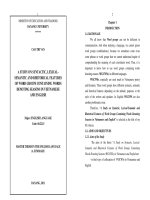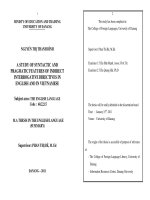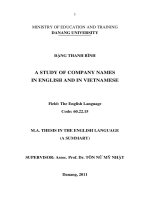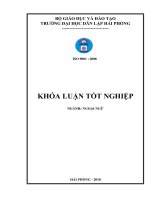Providing early language education in Vietnamese context
Bạn đang xem bản rút gọn của tài liệu. Xem và tải ngay bản đầy đủ của tài liệu tại đây (248.7 KB, 8 trang )
TẠP CHÍ KHOA HỌC SỐ 33/2019
125
PROVIDING EARLY LANGUAGE EDUCATION
IN VIETNAMESE CONTEXT
Dang Thi Quynh Trang
International School - National University Hanoi
Abstract: There is a common belief that providing early language education facilitates
learners’ language acquisition. This belief is supported by critical period hypothesis
defined as a biological period that humans are set to acquire a language. However, much
research has found the opposite. This paper critically discusses the evidence supporting
‘the younger the better’ viewpoint and counter-evidence against this belief. More
importantly, it brings into concern the constraints of introducing early language
education in the context of Vietnam.
Keywords: foreign language, critical period hypothesis, early language education.
Email:
Received 25 May 2019
Accepted for publication 10 August 2019
1. INTRODUCTION
Approximately 1.5 billion people speak English as second or foreign language while
there are nearly 400 million native speakers of English [1]. This figure has made English
qualified to be given the status of a “global language” or an “international language” [8].
To gain this standing requires the language not only to have a large number of native
speakers but also to be largely used as a second and foreign language in other countries.
Having the status of ‘a global language’ or ‘an international language’ is one of the
explanations for English to be introduced as a foreign language to the early age in many
countries. Vietnam has acknowledged the status of English and made it to be the official
compulsory subject in primary levels at grade 3 to 5 [10]. There has been an increasing
concern among parents and policy makers on introducing English to grade 1 and 2 or even
earlier. However, introducing English to earlier age needs further research and serious
considerations. The common belief ‘the younger the better’ cannot be relied on to make
such an important decision as research has found the opposite. In this paper, I would argue
that introducing English to young age does not guarantee success in English teaching and
learning context in Vietnam. This paper will firstly review the research findings supporting
126
TRƯỜNG ĐẠI HỌC THỦ ĐÔ HÀ NỘI
‘the younger the better’ belief, then discuss the opposite view and finally present issues
related to introducing English to young age in Vietnamese context.
2. RESEACH FINDINGS SUPPORTING ‘THE YOUNGER THE BETTER’
AND THEIR LIMITATIONS
The assumption that the younger learners learn a language, the better they learn has
received support from cognitive, neuropsychological and affective perspective. According
to cognitive point of view, learners benefit from starting learning languages early in life as
they possess an innate ability to acquire languages. Brown, Cazden and Bellugi (1969) and
Cazden (1972) supported this point of view by claiming that nearly all children learn a
minimum of one language effortlessly without apparent guidance from parents or others.
This perspective received theoretical support from Chomsky (1972) and McNeill (1970)
suggesting that there is an innate language mechanism, and also from Penfield and Roberts
(1959) with critical period hypothesis. Critical period hypothesis shared the idea that
humans are biologically set to acquire language at a specific period. After this critical
period, they are less likely to successfully acquire languages [5]. The strong version of
critical period hypothesis suggests that native-like accent is not likely to be acquired after a
particular period or a critical period. Critical period hypothesis received some support from
Johnson and Newport (1989), DeKeyser and Larson-Hall (2005), and Scovel (1988).
Among those proponents, Johnson and Newport (1989) seems to give decisive and strong
support for a critical period. Their studies revealed that those starting at age 7 reached the
level of proficiency of native speakers whereas those starting between 7 and 15 years old
show lower performance levels. Of those starting after 15 years old, their distribution of
performance is varied. Their study seems to be in favor of a critical period which is 7 years
old. However, Johnson and Newport study was criticized for not making age factor
independent of social and linguistic background of participants. In order to make the
existence of a critical period for language acquisition convinced, there should be evidence
that is independent of social and linguistic factors. Bialystok (1997) claimed that three
factors raising question (the participants involved, structures in the test and the task used to
assess competence) did not support the conclusion that outcomes of the study are the result
of age factor. The data gained from Johnson and Newport study have also been re-analysed
by Bialystok (1997). The re-analysis reveals that the age of 20, instead of 17 as Johnson
and Newport (1989) claimed showed strong correlation between age of arrival and
performance levels. ‘The tendency for proficiency to decline with age projects well into
adulthood and does not mark some defined change in learning potential at around
puberty’.Another study in support of critical hypothesis period was conducted by
Patkowski (1980). The study involved 67 immigrants in the US, 33 of whom arrived before
TẠP CHÍ KHOA HỌC SỐ 33/2019
127
they were 15 while 34 immigrants arrived after the age of 15. The study found that there
was “an age related limitation on the ability to acquire full command of a second
language”. However, the participants were tested in the environment that English was
spoken as a first language, which differs substantially from the foreign environment in
which Vietnamese students are learning English. Therefore, this finding cannot be
generalized and applied into foreign language environments. One of the theoretical
explanations for the critical period hypothesis comes from neurological cognitive.
`Penfield and Roberts (1959) suggested that after maturation, the brain experiences the loss
of plasticity, and therefore, the potential for development is mitigated. Lenneberg (1967)
suggested that the optimum period coincides with the lateralization process of language
function to the brain left side. This neurological basis for the critical period hypothesis has
been doubted by Krashen (1973) as the exact age at which lateralization occurs was
challenged. Young learners’ attitudes, motivation and anxiety have been brought into
concern to justify an early start. Children’s attitudes are considered to be more positive;
they are also considered to be more motivated and are less affected by anxiety than older
students [7]. However, some argue that although adult and adolescent learners are less
open to the target language, they can be highly motivated and committed toward second
language acquisition.
3. OLDER LEARNERS ALSO ACHIEVE SUCCESS
In recent years, early foreign language education has attracted much concern as
counter-evidence against “the younger the better” has presented (García Mayo & García
Lecumberri, 2003; Muñoz, 2006; Nikolov & Djigunović, 2006, 2011, for example).One of
the most famous among these studies is the study of Asher and Price (1967), which showed
that adults surpassed children and adolescents at all aspects of language complexity. The
participants involved 96 learners from grade 2, 4 and 8, and 37 undergraduate students who
had not had any previous experience with the examined language. Asher and Price
recognized that the chosen samples included undergraduate students who may possess high
mental ability compared to the children. However, they cited Pimsleur (1966) that “general
mental ability is a lightweight factor in L2 learning accounting for less than 20% of the
variance”. Another study by Politzer & Weiss (1969) on phonology also found that the
older the participants are, the higher the test scores are. The participants of this study
included those from grade 1, 3, 5, 7 and 9. Concern can be raised as many children after
grade 3 had had some experience with the target language and many of those at grade 7
and 9 have received regular training in this language. Politzer and Weiss, however,
suggested that such instruction can only directly affect performance of a small part of the
test items.
128
TRƯỜNG ĐẠI HỌC THỦ ĐÔ HÀ NỘI
One of the studies of FLES (Foreign Language in Elementary School) programs
reported in Singleton & Ryan (2004) investigated the English teaching in grades 1 to 4
(learners at the age from 8 to 11) in primary schools in Swede [9]. In pronunciation test,
results increased consistently with age in all aspects of assessment (entire utterances,
individual speech sounds and overall impressions). Similarly, in the listening
comprehension test, older children gained higher scores than younger ones. Two projects
carried out at University of the Basque Country and the University of Barcelona in Spain
provide significant evidence for the viewpoint “the older, the better”. The project by
University of the Basque Country includes participants who learn English as a third
language (after Basque and Spanish). English was traditionally first taught to learners at
their age of 11, however, it has lately been introduced when the learners are at the age of 8.
The project aims at comparing performance of those starting at 11 and those starting at 8
and also investigating children who are exposed to English at the age of 4. The finding of
the project is that in all examined categories (listening comprehension, written
comprehension, grammaticality judgement, oral proficiency, written production, sound
perception and pronunciation), the later starters surpass the earlier beginners with the same
exposure time [3]. The project of University of Barcelona produces similar result. This
project involves subjects who start learning English between the age of two and six, at the
age of 8, 11, 14 and after age 18. The project also reveals that with equal exposure time,
the later starters do better than the earlier ones in all examined tasks (written tests, oral
story-telling, oral interaction and listening comprehension test) [9]. Two studies carried out
by Nikolov (2000) provide counter-evidence against the strong version of the critical
period hypothesis. Study 1 involved 20 adult-onset Hungarian learners; in study 2,
participants were 13 Hungarians starting to learn English at the age of 15. Six out of 20
participants were thought to be native speakers by native judges. The second study
revealed that five out of 13 participants were often mistaken for native speakers. Thus, it
cannot be the case that native-like accent is not possible to be acquired after a critical
period as suggested by the strong version of the critical period hypothesis.
4. STARTING A FOREIGN LANGUAGE EARLY IS NOT NECESSARY TO
HANVE NATIVE - LIKE PROFICIENCY
The proficiency level of native speakers has been set as a criterion to assess the ability
of second language learners, as Cenoz & Genesee (1998, p18) claimed, “bilinguals, in and
outside the school, are usually evaluated against “monolingual” competence in their nonnative languages”. Though it may be reasonable to compare the competence levels of
TẠP CHÍ KHOA HỌC SỐ 33/2019
129
second language learners to those of native speakers, it is also necessary to recognize that
the concept of native speakers is restricted by culture as remarked by Hill (1970).
Moreover, as Cook (2002, p.6) suggested while “ultimate attainment is a monolingual
standard rather than an L2 standard”, the standard for a second language learners’
achievement should not be the same as that of monolingual speaker. Davies (2003) brought
into concern how difficult defining native speaker is. “The distinction native speaker - nonnative speaker is at bottom one of confidence and identity”.
Taking native-like proficiency standard into account, it is hard to draw into conclusion
whether young starters or older starts are likely to have native-like proficiency. On the one
hand, there is research that has drawn on the conclusion that starting to learn a foreign
language at an early age is crucial to have native-like proficiency. To name one of the most
famous studies, the study carried out by Asher and Garcia (1969) showed a connection
between age of arrival into a host country and its language learning. The study involved 71
Cuban immigrants to California whose ages are from 7 to 10 years and most of them have
been in the United States for five years. Although none of them gained native-like
pronunciation, many of them were considered to have near-native pronunciation. The
highest proportion of those who were regarded to have near-native pronunciation was the
group of children arriving in the United States between the age of one and six. The study
also found the relationship between the age of entry and the native-like accent. It was
found that the younger the children entered the United States, the more native-like accent
they had. On the other hand, it is undeniable that there has also been much research finding
that starting a foreign language as adults can also enable learners to have native-like
proficiency. For example, Birdsong (1992) found that a majority of his late learner
participants were able to achieve as high proficiency as early starting learners and native
speakers in grammaticality judgement task although the late starting group generally
performed worse than the early starting group. Loup et al. (1994) reported two adult-onset
learners who were able to achieve native level of competence in Arabic. Other studies
(Bongaerts, 1999; Bongaerts et al., 2000; Bongaerts et al., 1995; Bongaerts et al., 1997;
Palmen et al., 1997, for example) found some starting their second language after the age
of 12 were able to gain the same pronunciation levels as native speakers. Similarly, Van
Boxtel et al. (2003) claimed that some late starters of Dutch successfully achieved nativelike levels on a grammaticality judgement task. Thus, these above mentioned evidences
contradict the view of critical period hypothesis that those starting a second language after
a certain period in life are not able to achieve native-like competence. Hyltenstam and
Abrahamsson (2000, p.155) realized that there has not been any case of late L2 starter who
achieve native-like proficiency in all linguistic details. They also claimed that even those
130
TRƯỜNG ĐẠI HỌC THỦ ĐÔ HÀ NỘI
starting a second language early do not reach the proficiency level of native speakers in
every subtle detail. Research done by Hyltenstam & Abrahamsson (2000) showed that very
young L2 starters fail to achieve level identical to native speakers in lexico-grammatical
aspects. Similarly, other studies (Flege, Frieda & Nozwa, 1997; Guion, Flege & Loftin,
2000; Piske, Mackay & Flege, 2001) found that many experienced a second language
exposure very early in life could not speak L2 with the same accent as native speakers.
5. INTRODUCONG ENGLISH IN VIETNAMESE CONTEXT “MINIMAL
INPUT SITUATIION”
Foreign language learning environment differs from second language learning
environment in that the former does not provide sufficient exposure to the target input.
Moreover, foreign language learning environment is not able to generate and strengthen
motivation for learners to use English as they hardly have chance to use English for their
practical purposes. Hence, evidence for “the younger the better” belief which comes from
research involving immigrants immersed in the English speaking environment cannot be
applied to foreign language environment where the primary source of input comes from
classroom settings as Larson - Hall (2008) called it “a minimal input situation”. Supposing
that critical period hypothesis is true and an ‘innate language mechanism’ exists, with such
insufficient amount of input, “the formation of a morphological, syntactic and
phonological system” cannot be created [4]. As suggested by Larson - Hall (2008, p.37), in
order for learners to take advantage of implicit learning, there must be sufficient amount of
input provided to them. This may explain why early starters are outperformed by later
starters as older learners can take advantage of explicit learning [2].
Constraints in introducing English early
Assuming that introducing English early provides benefits to students, introducing
early language learning in Vietnam has faced some challenges, including the lack of
qualified teachers and the lack of continuity. Vietnamese English teachers at primary
schools, especially in rural areas have been reported to be in shortage and not qualified
enough. Three quarters of primary schools examined employ permanent English teachers
while the others have their English teachers hired from other schools. Teachers without
university qualification have also been employed [6]. Besides, the low salary of English
teachers at primary school (at around 3 million VND, equivalent to 150 USD) [6] has
indirectly discouraged qualified English teachers from teaching at primary schools as they
are able to look for jobs that provide higher pay at other sectors. The lack of teachers may
TẠP CHÍ KHOA HỌC SỐ 33/2019
131
result in the increase in workload for each teacher, hence taking them out of their time to
improve their professional skills and English competence.
Another constraint that may devalue ELL is the discontinuity, that is, “the lack of
coordination between the elementary and the secondary programs”. The lack of continuity
and transfer has been a major challenge in ELL in many educational contexts. The
discontinuity may result from different issues such as that students are not placed at an
appropriate level or that learners may stop learning the language learnt in ELL years or that
learners may find themselves short of expectation, resulting from problems in classroom
methodology. The discontinuity may result in the loss of motivation, which is widely
recognized as an unexpected challenge. The typical classroom activities and topics may
make young learners bored as they have been exposed to them very early.
Age factor is not the main issue
Many scholars suggest that age should not be given much emphasis in foreign
language contexts. From their perspective, the age factor is not the primary issue. Besides
age factor, there are other factors that also contribute to success in second language
acquisition. Some of them which are considered more important are the quality and
quantity of early provision, teachers, programs, and continuity. Moyer (2004), in the study
on how ultimate attainment is affected by opportunities and intentions, found weak
“directness and independence of age effects”. Besides age of arrival and length of
residence, psychological factors make up nearly three quarters of the degree of attainment.
Moyer (2004, p.144) found that there are other factors that affect quality of access to the
target language, including duration, quality of experience, consistency over time and
intensity or extent of orientations.
6. CONCLUSIONS
The critical period hypothesis and its effect on second language acquisition remains a
controversial issue. This paper critically discusses both supporting evidence and counterevidence against critical period hypothesis. I finally draw on the conclusion that the strong
version of the critical period hypothesis is less associated with foreign language learning,
suggesting that there is much possibility that later beginners acquire native-like proficiency
as discussed evidence in this essay shown. There are other factors that contribute to the
success of language teaching and learning other than the optimal age. More importantly,
providing early language education in Vietnamese context would not bring much
effectiveness. Instead of considering to introduce English to younger students, there should
be more focus on improving English teachers’ quality and strengthen the continuity of
English curriculum.
132
TRƯỜNG ĐẠI HỌC THỦ ĐÔ HÀ NỘI
REFERENCES
1.
Crystal D. (2012), English as a Global Language (2nd, ed) Cambridge University Press,
Cambridge.
2.
DeKeyser R., Explicit and Implicit Learning, in The Handbook of Second Language
Acquisition, M.H.L. C. Doughty, Editor (2003), Blackwell: Oxford. p.335.
3.
García L. M. L., Gallardo F. García Mayo M. P., García Lecumberri M. L. (2003), English FL
pronunciation in school students of different ages.
4.
Larson-Hall J., 24 (1), 35-63. (2008), “Weighing the benefits of studying a foreign language at
a younger starting age in a minimal input situation”, Second Language Research 24, p.37.
5.
Lightbown P., & Spada, N. M. (2013), How languages are learned, Oxford University Press,
Oxford.
6.
Nguyen T. (2012), English Language Policies for Vietnamese Primary Schools and Issues of
Implementation in Rural Settings.
7.
Nikolov M. (2009), The age factor in context, in The age factor and early language learning,
Walter de Gruyter GmbH & Co: Berlin. pp.1-37.
8.
Seidlhofer B. (2003), “A concept of International English and related issues: from “real
English” to “realistic English?”, Council of Europe.
9.
Singleton D. R., L. (2004), Language acquisition: the age factor Multilingual Matters Ltd,
Clevedon, Buffalo, Toronto.
10. Van Hoang V. (2018), The Curent Situation and the Teaching of English in Vietnam.
VIỆC GIÁO DỤC NGOẠI NGỮ SỚM Ở VIỆT NAM HIỆN NAY
Tóm tắt: Người ta cho rằng giáo dục ngoại ngữ sớm tạo điều kiện cho việc tiếp thu của
người học tốt hơn. Niềm tin này xuất phát từ quan điểm cho rằng giai đoạn sinh học khi
còn trẻ của con người được tạo hóa thiết lập là để học ngôn ngữ. Tuy nhiên, nhiều nghiên
cứu đã chỉ ra điều ngược lại. Bài viết này thảo luận về các bằng chứng ủng hộ quan điểm
“càng trẻ càng tốt” và bằng chứng chống lại niềm tin này. Quan trọng hơn, bài báo cũng
thảo luận về những hạn chế của quan điểm giáo dục ngoại ngữ sớm ở Việt Nam hiện nay.
Từ khóa: Ngôn ngữ nước ngoài, giai đoạn vàng để học ngoại ngữ, giáo dục ngoại ngữ
sớm.









